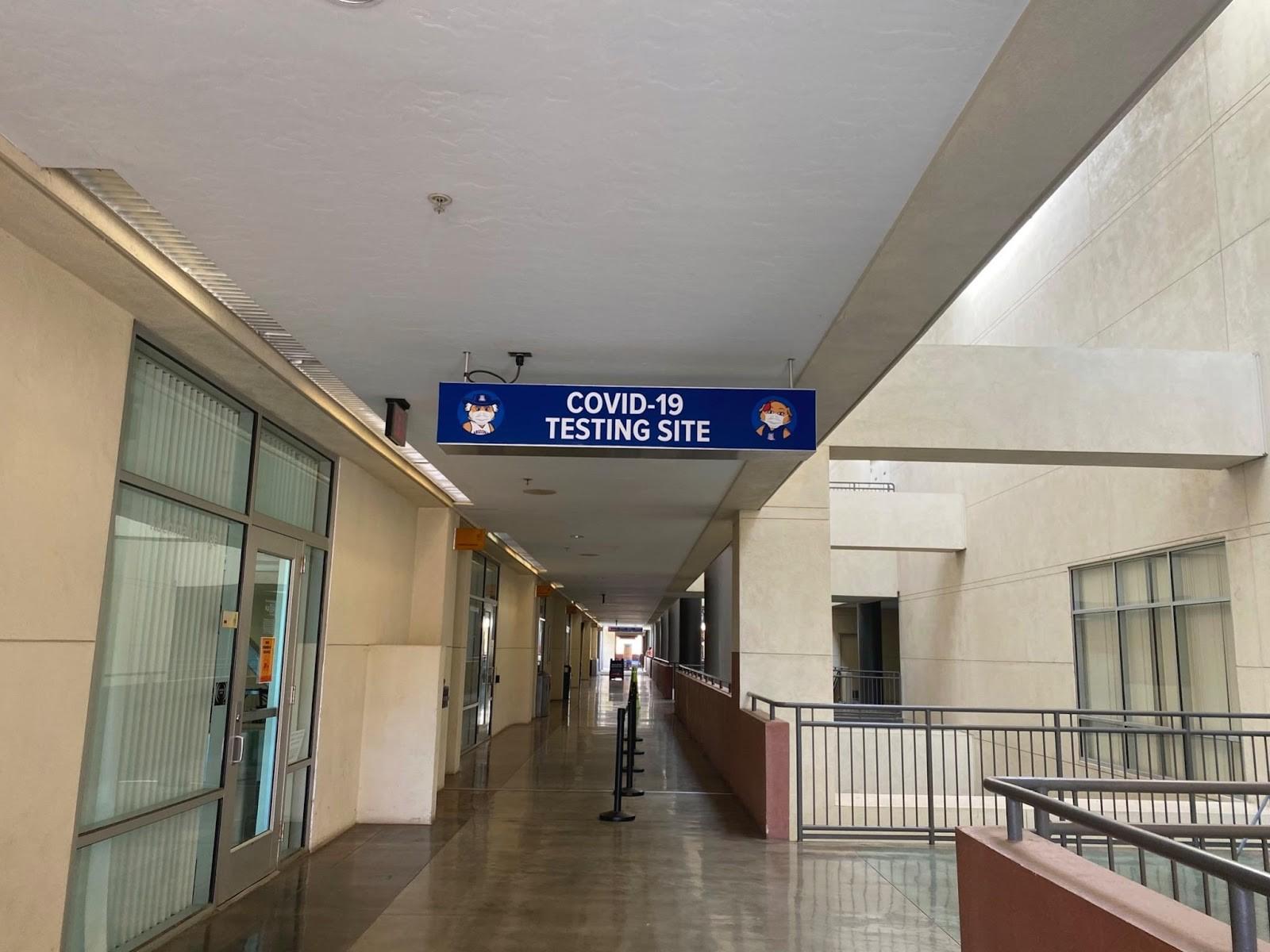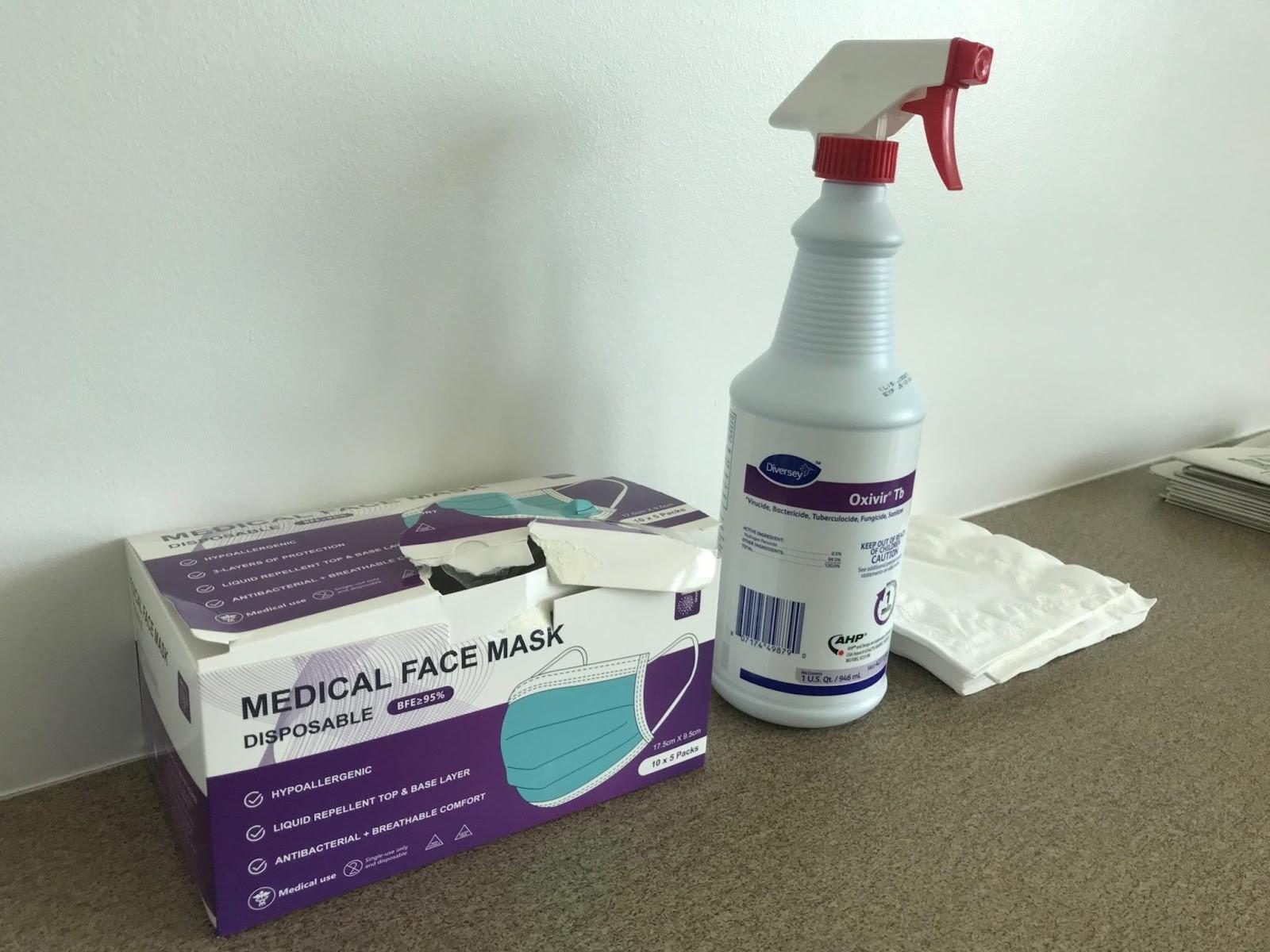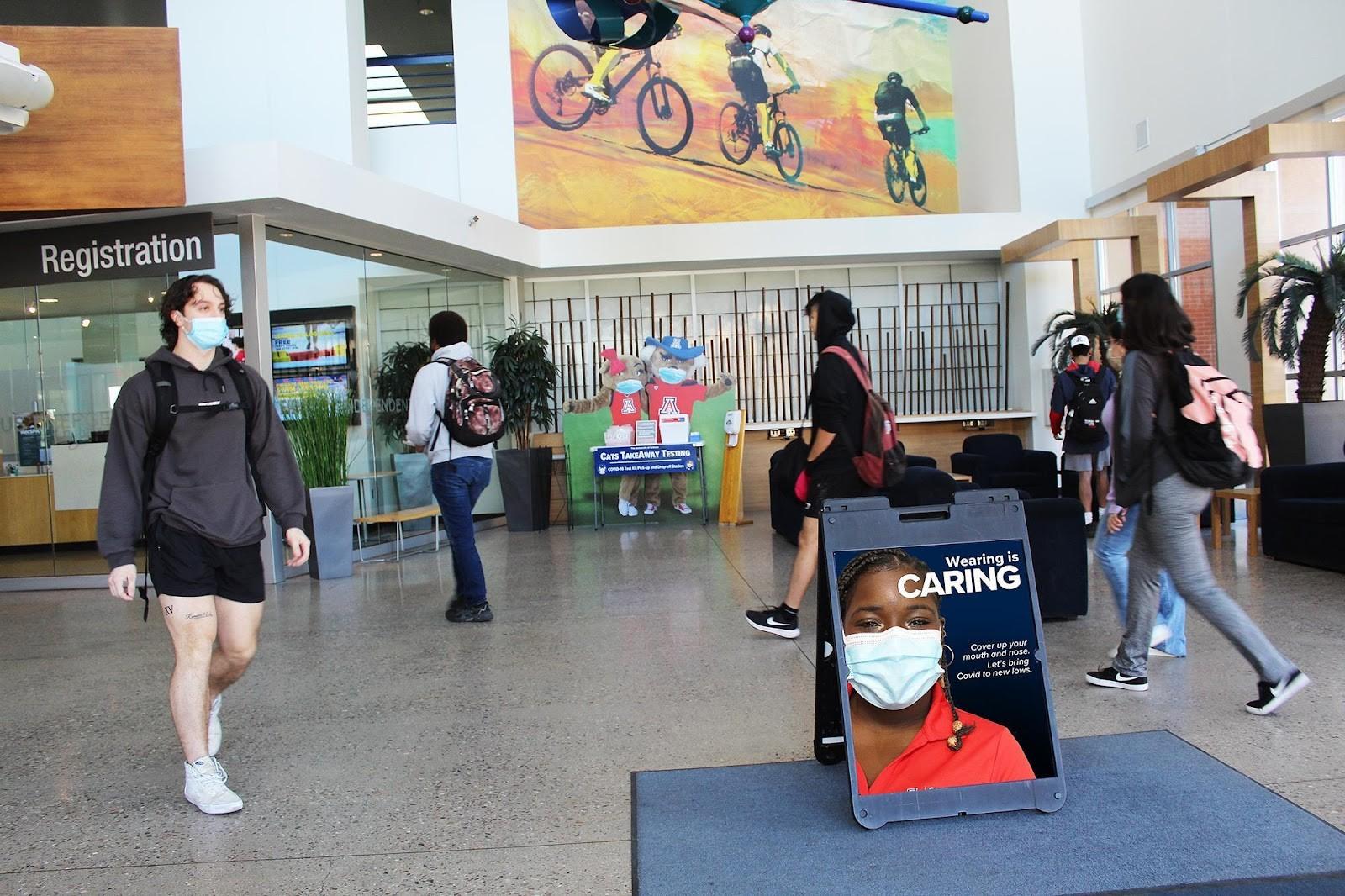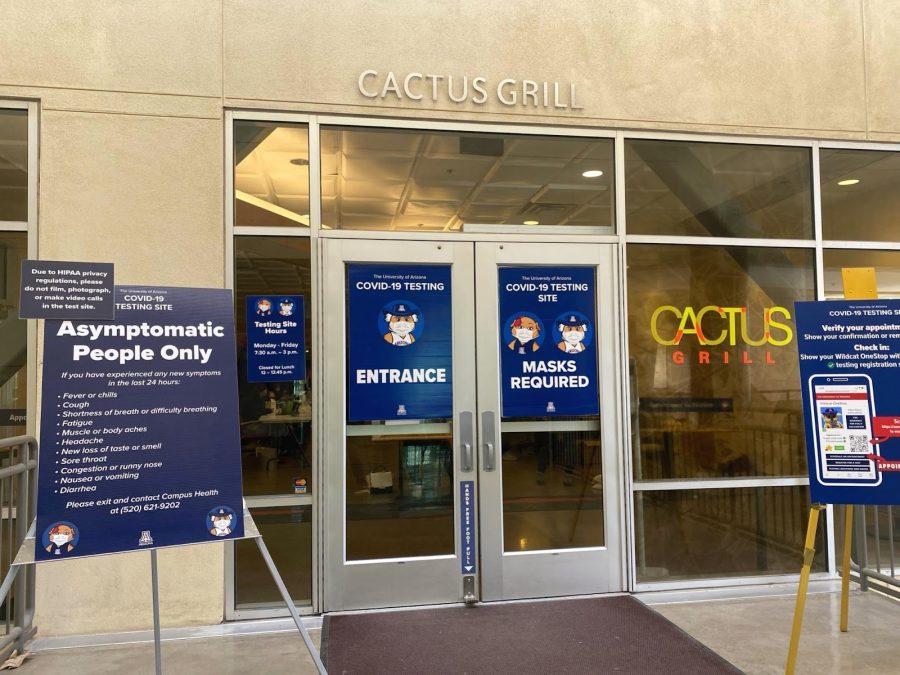The message came in an email halfway through spring break 2020: Students should take an extended vacation and classes would transition to online when they returned.
Two days later, a follow-up email urged students to stay home and not return to campus. By late March 2020, classes went fully online and COVID-19 was a pandemic.
This year’s spring break marks the second anniversary of the COVID-19 pandemic, and students at the University of Arizona still feel its effects all around campus. Ever-evolving mask mandates, regular COVID-19 testing, updated attendance policies and contact tracing have all become the university’s new normal.
And so has long lines at Student Union Memorial Center’s restaurants, canceled exercise classes at the Student Recreation Center and abrupt closures and unkempt public spaces due to employee shortages and new sanitation guidelines that are trying facilities staff.
As we begin the third year of the pandemic, we look back on the impact its first two years have had on the UA community.
Restaurant closures spur long lines and wait times
By Madison McCormick
The Student Union, like businesses nationwide, is struggling to find workers in part as a result of the COVID-19 pandemic.
Without enough employees, several student-favorite restaurants across the UA campus, including Cactus Grill, were forced to close and students find themselves waiting in long lines for longer periods of time at the restaurants that stayed open.
Todd Millay, executive director of the Arizona Student Unions, said wait times range anywhere from 15 to 18 minutes during peak hours, but this varies by restaurant and time of day.
Millay said some of the more popular dining locations, like Chick-Fil-A and Panda Express, have seen wait times of up to 30 minutes.
In a Zoom interview, Arizona Student Unions Assistant Director for Human Resources Eric Kay said a shortage of non-student benefits-eligible employees is partly to blame.
According to Kay, data from the Human Resources Department shows that the Student Union had more than 235 full-time employees before the pandemic, and that number is now down to 206, with 40 full-time position vacancies.
In response to the staff shortage, Arizona Student Union management has asked existing full-time staffers to manage multiple restaurant locations for additional pay. Kay said this coverage strategy has worked thus far, but spreading employees thin is not a long-term solution.
To further compensate for the deficit of full-time employees, the student union is operating at 85% of its pre-pandemic capacity, with six of its 34 restaurants closed. Millay said the 28 dining locations still open are generally back to normal hours of operation, though those hours vary.
Among the closures are Mexican restaurant Sabor, which switched to operating as the home base for the GrubHub food delivery robots before Arizona Student Unions ended their partnership earlier this month, and the beloved Cactus Grill, which has become a COVID-19 testing facility.

“Some of our wait times are declining as the new robots on campus are getting food to people before having to come wait in line,” Millay said in an email before the partnership ended. “We are seeing over 600 robot deliveries every day already and this is a new and expanding service.”
Bagel Talk, La Petite Pâtisserie, Core and the Arizona Room also shut down during the pandemic. Millay said these restaurants will likely remain closed, but the Union is working toward reopening Sabor this semester.
Students can also look forward to an Indian food restaurant replacing La Petite Pâtisserie in the Global Center.
Disinfecting UA campus top priority for facilities department
By Diana Ramos
Before the pandemic, the University of Arizona Facilities Management Department’s priority was to ensure the lawns were mowed, the trees trimmed and the common areas were clean.
Since the COVID-19 pandemic, those priorities have shifted and intensified.
Facilities purchased millions of masks and high-quality cleaning supplies to disinfect classrooms, restrooms, offices, hallways and nearly all high-touch surfaces around campus.
“It is a financial change; it is double the cost,” said Assistant Facilities Management Vice President Chris Kopach.
Kopach said the university has purchased over 1.5 million KN95 masks since the beginning of the year.
To accommodate the Centers for Disease Control and Prevention guidelines, the university established a COVID-19 cleanup team. Within an hour of receiving a positive COVID-19 case report, the team disinfects the exposed area.
Kopach said the university didn’t lay off any maintenance staff because of the pandemic, but the department’s priorities changed which has impacted staffing.
RELATED: RecycleMania teaches students to implement more sustainable living practices
Before the pandemic, custodians cleaned classrooms three times a week. Now, they clean them five times a week.
Hallways, restrooms and high-traffic areas are disinfected multiple times per day. To prioritize student health and safety, the UA decided to focus specifically on cleaning classrooms. Because many office jobs are now conducted virtually, cleaning office spaces took the backseat.
Among the maintenance staff’s new custodial duties is restocking surgical masks, hand sanitizer, paper towels and disinfectants in classrooms around campus.

“They give us much more work now,” said Amanda Norzagaray, a custodian for the Louise F. Marshall Building.
Through key performance indicators, Facilities Management determines quality levels of cleaning where they evaluate how much per square foot an employee can cover and at what level. On a scale of one through five — one being best and five being worst — the UA scored between one and two, Kopach said.
In addition to observing an expanded list of custodial tasks, the Facilities Management Department also ran the vaccination Point of Distribution on campus from Jan. 19 to June 25, 2021. The POD ultimately vaccinated around 250,000 people in the six months it was open, including members of the Tucson community, UA students and university faculty and staff.
Limited rec staff has to pull all the weight
By Cameron Jobson
After closing campus in the spring of 2020 because of the pandemic, the University of Arizona Recreation Center reopened that summer with staff shortages ranging from lifeguards and fitness instructors to managers and weight room monitors.
The shortages continue as the pandemic enters its third year.
Troy Vaughn, the director of the Student Recreation Center, said the spring semester usually requires a staff of about 550 student employees, but at the start of the semester in January only 349 positions were filled.
Some of this loss is already accounted for, due to students’ schedule changes, but the facility still has 14 different positions with open applications.
The shortage of Rec Center student staff has less to do with the pandemic itself and fears of contracting the virus and more to do with pandemic-related responsibilities including cleaning the gym and enforcing mask mandates among patrons.
“[COVID-19] has taught us a lot about repositioning and shifting priorities,” Vaughn said. “We re-energized our staff to better enforce cleaning and understand the hot spots.”
The Rec Centers student staff dedicates time to disinfecting equipment with electrical sprayers, distributing masks and enforcing the university’s COVID-19 policies.

Keeping up with an evolving pandemic and dealing with resistant patrons was not in the original job description. Some student employees are part-time and may not have anticipated these changes.
“From an employee mental health standpoint, the mask mandate has been terrible,” Vaughn said. “It’s been difficult to manage.”
Since Sept. 6, 2021, the Rec Center has issued over 165,000 masks. Surgical-grade face coverings are now required in the facility and in all UA buildings.
While most patrons are respectful, the fated pushback falls on the shoulders of the student staff. Vaughn said many students don’t return to work because they don’t want to be the “enforcers.”
Remaining employees feel “spread too thin,” said aquatics supervisor Tyrel Malmgren.
“Some of these maintenance tasks are really nitty-gritty,” Malmgren said while checking his assigned duties. “Scrubbing the grates, cleaning lane lines and hosing the deck are almost jobs of their own.”
Sometimes, these duties can’t all be completed in one shift.
“There have been plenty of shifts that only have two [life]guards working because we can’t find coverage,” Malmgren said. “People are constantly scrambling.”
Due to the employee shortage, Malmgren said they are looking to hire “just about anyone.” As a result, the level of performance and expertise has decreased.
“You can see the difference in quality of lifeguards,” Malmgren said. “When it’s not competitive, the skills go down so much it’s almost concerning.”
Regardless of the current staff, Malmgren said patrons seem pretty happy. Programming is continuing as scheduled, at about 90% capacity.
“We are running as normal as we can,” Vaughn said. “We’re doing our best. We’re surviving, but it’s not been easy by any means.”
The faculty has been brainstorming innovative ways to recruit new employees. When the statewide minimum wage increased from $12.15 to $12.80 in January, the Rec Center pushed its minimum to $13.
As the Rec Center enters the third year of the pandemic, Vaughn said he is grateful for their current staff of student employees.
“Our students have been nothing short of absolutely amazing,” Vaughn said. “The positivity that they bring and the commitment they have for student safety and for user safety … they’ve come through with flying colors.”
*El Inde Arizona is a news service of the University of Arizona School of Journalism.
Follow the Daily Wildcat on Twitter









